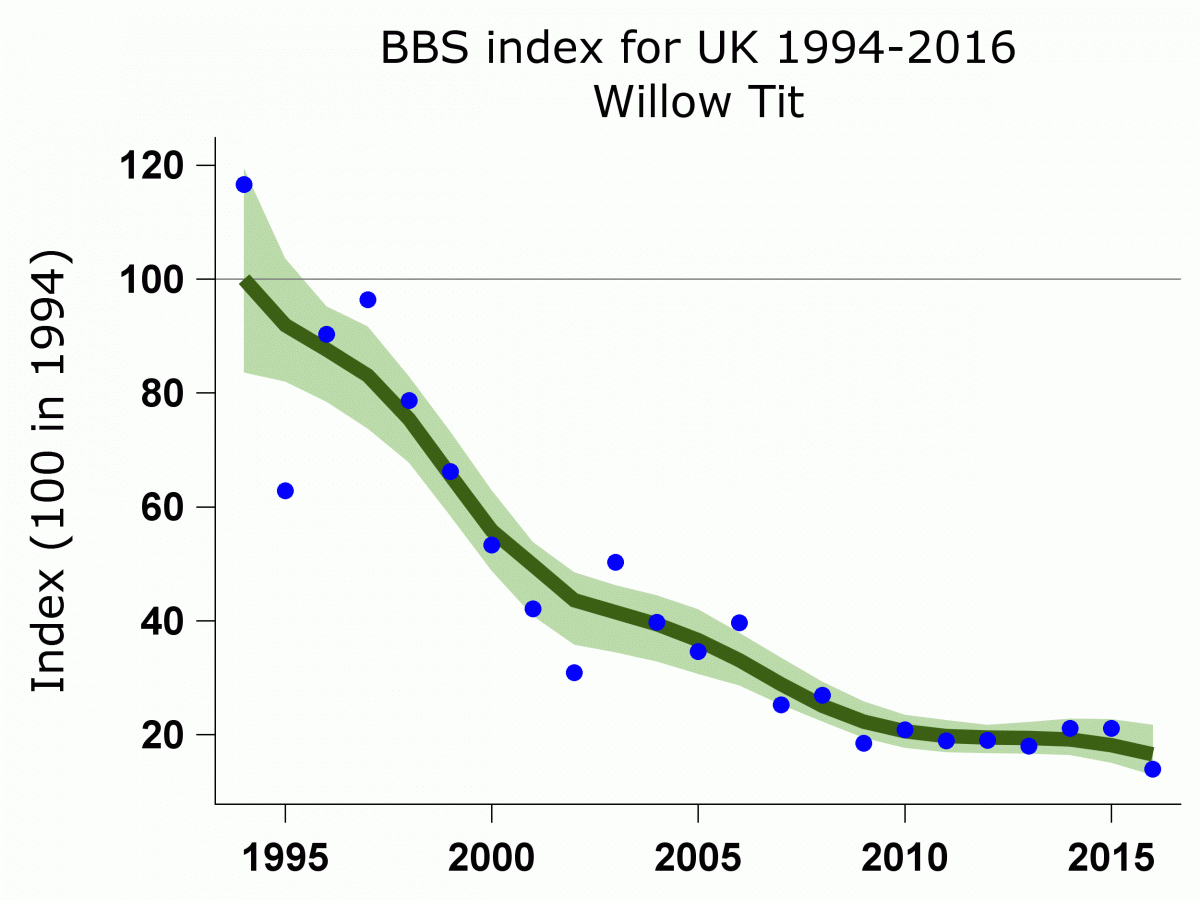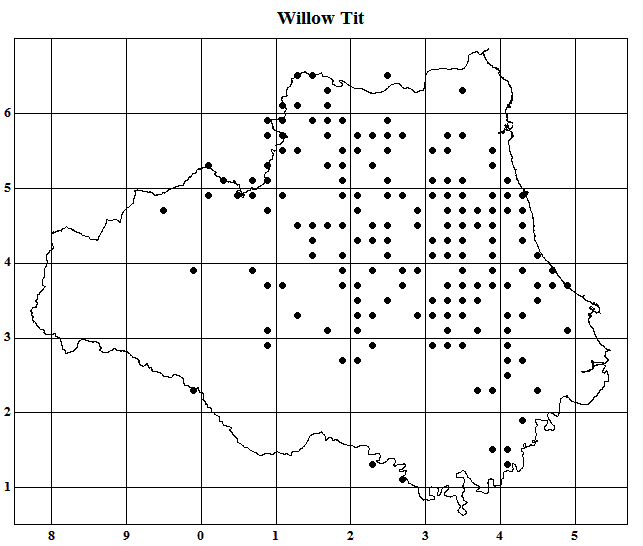
DBC Willow Tit Survey
Nationally, the Breeding Bird Survey data (from the BTO) indicates a serious decline in the Willow Tit population of Willow Tit.(also illustrated by the results of Bird Atlas 2007-11)

Locally, the fieldwork for the 2007-11 atlas indicated an increase in distribution, with about 165 occupied tetrads, as opposed to 91 in A summer atlas of the breeding birds of County Durham. This could be partially due to increased observer effort. The 2007-11 distribution map is shown below together with the equivalent map for the similar Marsh Tit. It is highly likely that the real population of Willow Tit in County Durham is not yet properly understood, we are likely to have more Willow Tits that the reports and records would seem to indicate.


Using an average density of 3-4 pairs per occupied tetrad, the Summer Atlas estimated a county population of 300 pairs. The birds of Durham, in 2012, felt that this might have been a slightly low estimate for the time, but in the light of the national decline “is probably now an over-estimate”. However, this was written without the evidence from the 2007-11 atlas. More recently the report Rare breeding birds in the UK in 2015 (published December 2017) gives a figure of 100 pairs in County Durham, second only to Yorkshire with 134, out of a national total of 678.
Elsewhere, a recent report on survey work in a single 10-km square in County Durham suggests a minimum of 112 pairs in that area.
Survey Aims
Against the background outlined above the first aim of our survey will be to determine more accurately the distribution and range of the species in the county and to reach a good estimate of the number of pairs present.
The second aim will be to gather information on the Willow Tit’s habitat preferences and to try to understand why it is performing better in County Durham than in most of the rest of the country. This should also enable us to consider the future habitat management regimes which might be needed to maintain a healthy population.
The survey may be in two or more phases, with the first season used to establish distribution, but with additional options on the recording form to collect information on habitat and numbers, and with a second phase to fill in gaps in the information collected in the first.
Identification
Some aspects of visual identification are dealt with in the field guides.The journal British birds published a more detailed review article by Richard K. Broughton in its November 2009 issue (Vol. 102, pages 604-616).
The video on the two species in the BTO's extensive collection of Bird ID Workshops provides useful information on identification both by sight and by sound. Further recordings of the songs and calls may be found on the xeno-canto website.
Willow Tits can be secretive and surveys in other areas have found the birds are often located only by playing the song as a lure. This can be done using a recording on a smartphone. However, this should only be carried out prior to the breeding season and probably not after the end of February. It should also not be used in already known territories and should not be repeated at intervals of less than 200 metres.
Data Capture
Once you have located your Willow Tit, completing the survey form is much less complicated than it might look at first sight. Please fill in as much of it as you can, but note that partially-completed forms may provide us with useful information, particularly in regard to location. Please read the following notes –
O.S.Grid Reference is a key piece on information for location and mapping of territories. One relatively simple way of determining this is by using the UK Grid Reference Finder website. The Ordnance Survey also provides a simple Beginner's Guide to grid references, useful for any who are unfamiliar with their use.
Habitat
In County Durham Willow Tits are not restricted to low lying damp woodlands - in fact they thrive on thin soils on exposed free draining Limestone in dry gorse & thorn copses.
The key habitats to check are likely to be:
-
Mature thorn copses;
-
Successional natural woodland habitats - eg Birchwoods with shrub understorey;
-
Natural regeneration on brownfield sites - eg Scots Pine and scrub on former industrial site/pit heaps;
-
Woodland edge on larger blocks with successional naturally regenerating edge;
-
Larch plantations in the county can hold birds although at a low density;
-
Linear sites with successional vegetation & limited canopy tree species - wagonways/some areas of riversides;
-
Lowland heaths, such as Waldridge, Bearpark, Pity Me, Greencroft etc;
-
Recently established 'community woodlands' - overplanted & regimented planting schemes leading to poor quality young woodlands with a mass of deadwood. These are great for Willow Tits and the population has increased over last decade in these areas;
-
Mature thorn copses (Hawthorn, Blackthorn, Elder).
Nests
Since Willow Tits call constantly during the nest excavation process the nest site is often easy to find. The contents of some nests can be viewed with the naked eye, while a telescopic inspection mirror may help for nests sited higher in a tree. At all times the safety of the birds must be the first priority, so we only want this information when it can be obtained without risk to the birds.
How to Take Part
We would like as many people as possible to get involved with this survey, but we need to deploy the observer effort over the lowland parts of the whole county. If you would like to participate please e-mail Durham Bird Club using the subject line "Willow Tit Survey". Please indicate your preferred area for fieldwork, but also how far you are prepared to travel.
Anyone preferring to correspond by post should write to:
David Sowerbutts
9 Prebends Field
Gilesgate Moor
Durham DH1 1HH
A recording form is available below. Please complete a separate form for each bird/pair you find - though it is not necessary to complete one each time you encounter what you believe to be the same bird or pair. We would also like to know when you have thoroughly surveyed a potential site but found no Willow Tits.
Resources and Downloads
Identification article from British Birds
BTO video
Audio file provided by RSPB (approximately 2 minutes)
Durham Willow Tit Survey Information and Instructions
Durham Willow Tit Survey Recording Form
BTO Health and Safety guidance



